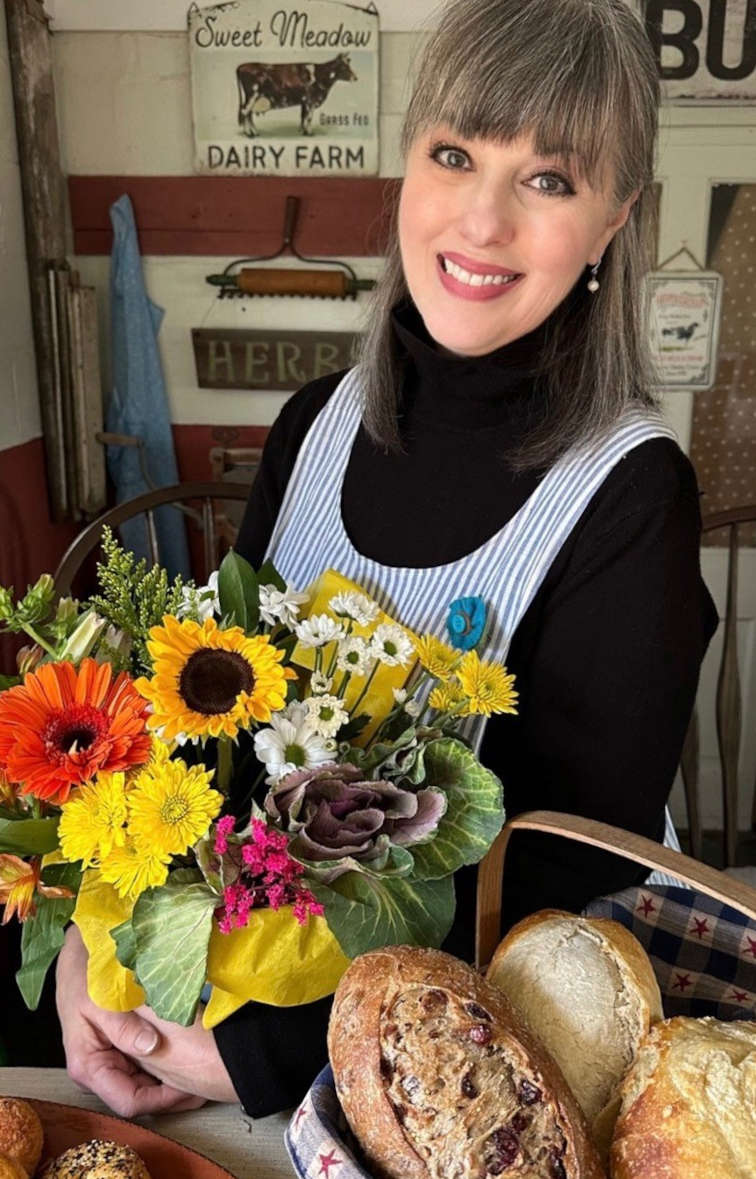Rainbows & rainstorms, heat & humidity, flowers and fruit…welcome July! So far summer has brought us abundant rain, incredible heat, and formidable wind gusts. We tied down everything that might blow away, slipped on raincoats and boots to unclog gutters before dawn, and tried to beat the heat with homemade ice cream and root beer floats.
And while July on the farm is brimming with much to do, there’s also much to enjoy…a gorgeous full moon, fantastic flowers, and sunsets that are unforgettable.
The abundant summer rains have given us field corn that is absolutely towering!
“Knee High by the 4th of July!”
I’m guessing this old saying is one that most of you have heard hundreds of times, but if it’s new to you, here’s a little background.
It’s said the first time farmers began using this phrase was in 1846…
“It has been considered that if corn was knee high
by the Fourth of July that the crop was sure and safe.”
~Iowa Sumner Gazette, 1846
And so for the last 179 years, it’s been a ruler to measure just how bountiful the harvest will be…the corn crop should reach the height of a farmer’s knee by Independence Day, July 4.
As a Midwesterner, the phrase “knee-high by the fourth of July” is one I have heard all my life. However, (and we’re a tall family) take a look at this photo:
I have one question…
7 feet, 11 inches
Just exactly whose knee is this tall?!
Weather watching and chatting about it with neighbors is a country pastime that’s filled with fun and folklore: “Rain by 7, clear by 11,” or ”The higher the clouds, the finer the weather.” Each morning begins with its own story to tell…will it be warm and dry enough for bailing hay, or will the rain hold off for a family picnic? And oh, the old sayings make me smile – ”It’s hotter than Georgia asphalt.” and “You could fry an egg on the sidewalk.” Every day is a surprise, and so we learn to be flexible. I’d say Mark Twain put it best, “Everyone talks about the weather, but nobody does anything about it.”
It always seems during these “dog days” of summer that the farmers’ market is overflowing with pickling cucumbers. After my last trip to the market, I decided I might as well fill my basket and get a jump on pickle-making. Beside the counter was a stack of recipe cards for Refrigerator Pickles. I’d heard how simple they are to make, so I thought, why not give them a try? However; I almost tossed the recipe away because the directions just weren’t specific…”slice a few cucumbers and some onions, add some pickling spices.” Then I was to “pack in a brine” but what are the proportions of water and vinegar?
Yikes, 14 years as a cookbook editor had trained me to write very precise, step-by-step recipe instructions, and while I was hesitant, I threw caution to the wind and tried the recipe.
I’m so glad I did…the recipe was quick & easy, goof-proof, and the pickles were delicious!
Here’s my version of the original recipe…and you can certainly change up the ingredients any way you’d like-add some veggies such as carrot slices or green beans, use less sugar if you like a pickle that’s a bit sour, or toss in a dash less (or more) of the pickling spices. It’s all up to you, because as our grandmothers knew, sometimes the best recipes call for a “pinch of this, or dash of that” and are absolutely perfect!
Summertime Refrigerator Pickles
cucumbers
onions
1-2 t. Pickling spices
1 t. salt
1/4 – 1/2 c. sugar
1 c. white vinegar
1 c. water
pint-size canning jar
Slice enough cucumbers and onions to tightly fill a pint-size canning jar. Add pickling spices, salt and sugar to the jar. In a separate bowl, whisk together vinegar and water. Pour mixture over the cucumbers, filling the jar. Tighten lid; shake well to blend. Chill 24-36 hours; shaking periodically. Keep refrigerated; enjoy within one month.
This next recipe definitely isn’t new-fangled, it’s tried & true and handed down for generations. I can remember watching my grandmother make these Bread & Butter pickles in her country kitchen on summer days. That sweet memory is another simple pleasure to recall…flowered tea towel curtains, a square laminate-top table, and jars of pickles all lined up in tidy rows. And as the jars cooled down, it was my job to count the “pings” that each lid made, ensuring a successful seal.
The process isn’t complicated, but it does take time. I’ve often had someone ask me why I bother making these when it’s so easy to buy a jar of pickles off the grocer’s shelf.
I do it because it reminds me of my grandmother and her little white house surrounded by lilacs. I do it because I remember her enormous garden, flock of happy hens, and the aroma of homemade bread. I do it because those carefree days were an important part of my childhood.
Her original handwritten pickle recipe, along with a handful of other recipes, is safely tucked inside an old Ball jar, as are her sewing scissors…sweet and simple.
I guess it’s not uncommon to hear, “Why do you do it?” when it comes to some of these old-fashioned ways so many of us love. I once heard someone say, “If you have to ask, I can’t explain it to you.” And I agree…no, I don’t have to make pickles, but it keeps me in touch with a time I remember fondly.
Now, before I begin, here’s a bit of Farmgirl advice: if you’ve never used a water bath canner or prepared foods for pickling, read all that you can (I’ll provide some links below) before you begin. It’s of the utmost importance that care be taken to ensure preserved food is completely safe.
So, with all that said, don’t be a bit shy about rolling up your sleeves and giving these sweet and tangy pickles a try. After all, they got their start in true-blue farmgirl fashion. It’s said that farmers Omar and Cora Fanning began trading their pickles in the 1920’s with a grocer for basics they needed – such as bread and butter, hence the name! I love it…farm life has always been built on bartering. Hmmm, I wonder what I can swap for a jar of pickles?!
Maymie’s Bread & Butter Pickles
8-10 lbs. pickling cucumbers, thinly sliced, ends discarded
6 white onions, peeled and thinly sliced
2 green peppers, seeded and thinly sliced
3 cloves garlic, peeled
1/3 c. pickling salt
Brine:
5 c. sugar
1-1/2 t. turmeric
1-1/2 t. celery seed
3 T. mustard seed
3 c. cider vinegar
In a very large bowl, combine cucumbers, onion, peppers, and whole garlic cloves. Add salt and mix well; cover with cracked ice. Let stand for 3 hours; drain and rinse thoroughly. Place mixture in a large stock pot; add brine mixture. Bring to a boil; boil 5 minutes.
Carefully ladle hot pickle mixture into hot, sterilized pint canning jars; leaving 1/2 -inch headspace. Remove air bubbles by inserting a flat spatula into each jar and slowly moving around the jar edge. Wipe each jar rim, add sterilized lids, then secure to just “fingertip tight.”
Place each jar in the rack of a water bath canner that’s filled with simmering water, and carefully lower the rack. Jars must be completely covered with water. Let the water come to a boil and process for 15 minutes. Carefully lift the canner rack from the canner, gently remove jars and set aside on a heat- proof surface to cool. Listen for each jar lid to “ping” meaning the lid has sealed to the jar properly. You’ll also see a dimple in the center of each lid that indicates it’s sealed.
Yield: about 14 pints
National Center for Home Food Preservation https://nchfp.uga.edu/
USDA https://ask.usda.gov/s/article/Where-do-I-get-information-on-home-canning
Downloadable PDF https://ask.extension.org/kb/faq.php?id=867764
And whether you’re canning pickles, collecting eggs, or tackling every day cleanup – Farmgirls, you’re gonna need an apron!
I absolutely love aprons, and over the years I’ve gathered more than I could possibly ever need. Whether it’s a gingham pinafore with a flounce, a heavy cotton apron for outdoor work, or a pretty-in-pink glamping apron, whenever I tie one on, it gussies up whatever needs doing!
If you want to try your hand at making an apron, let me show you a favorite that is oh-so quick & easy.
When a friend gifted me this tea towel, it was just so charming, I couldn’t imagine using it to wipe up spills – wait, why not turn it into an apron?
Using fabric markers, I added a little rooster and bee artwork…just to keep the goat company!
I found a length of ribbon for the ties, and easily attached it to the top with buttons. ta-da, done!
There are so many terrific patterns and colors of tea towels and kitchen towels…let your imagination run wild. Make your apron a one-of-a-kind by adding buttons, rick-rack, or fabric yo-yos, and a colorful bandanna or blue jean pocket on the front will make a handy spot to tuck any necessities from seed packets to pliers.
MaryJane says, “I wear aprons because they say glamour.” When I first read this, I immediately shared it with a friend whose family raises cattle. Now, no matter if she’s cleaning stables, stacking hay, or wrangling a ½-ton beast, she knows she is still glamorous!
July is an ideal month for doing what makes us happy…watching the fireflies dance at twilight or swaying in a front porch glider. Around here, yard work is done for the day, which is a good thing, because I can hear the rumblings of thunder in the distance.
Which brings us right back to talking about the weather, yes:
“There’s a Lizzie brewin’!” (Translation: there’s a storm coming!)
See you next month, with more “tails” the farm!











Growing up in the northeast, “knee high by the 4th of July was an important saying for our corn crops. With a shorter growing season we had to get it planted as soon as was safe to be able get the corn to that growth on time. Hoping the weather cooperated.
I too have collected many aprons over the years. It seems as though I always wear the same select few. I like the idea of turning the towels into aprons. I wear mine full so would probably change the idea up a little to make it that way. So many possibilities. Thanks for the inspiration!
I have grandma’s recipes and my mom’s. I have used them to make all sorts of pickled items including bread and butters. Love them. It’s such a blessing to carry on the traditions!
I agree with you as I wear a full apron daily too. I love the above ideas but think it wouldn’t be too difficult to add a second towel for the top and two ribbons to tie behind the neck. Now I just need to find some towels! I may check out some antique shops to look for some cute vintage patterned ones. Cooking, cleaning, gardening… I wear my aprons for it all and would feel bare without one!
Me too, Nicole…inside, outside, holidays – a must-wear! Let me know if you find some towels and make one…would love to hear!
Oh what a terrific idea, another tea towel at the top or two stitched together to give it a little more fullness…let me know if you whip up your own version! Aren’t those old recipes treasures? I agree…carrying on the old traditions keeps all those sweet memories for the next generation.
I usually make zucchini relish I just opened my last jar just in time for the new batch to be made.
My gardens are happy and healthy and for a minute weed free.
I have different aprons for different times. One for one rug hooking one for cooking one for gardening.
Great post! and boy you will have corn early.
Oh Cathy, weed-free is a dream here! It’s been nearly impossible to keep up with them. Zucchini relish is so good…like you, I just opened the last jar of hot-pepper jam. Soon it’ll be time to make more! And you’re right…this morning I could smell the sweetness of the corn in the air as it’s all just begun to tassel. Time flies!
Ahhh…Pickling!! It is a memory permanently etched in my head. My family loved pickles…of any kind (but mostly the dill sliced or whole variety). I did NOT like pickling season as my job was to help pick the cucumbers and then clean the the cucumbers. I would sit on the step of an old cement foundation that held the topper to my father’s old pick-up truck (which he didn’t use in the summer because he needed it to haul things (i.e., hay, etc.) with a bucket of water, a bucket of cucumbers, and scrub all the “nubbies” off. I think maybe that is why I decided I didn’t like pickles LOL. Everyone in my family LOVED pickles…and it is a trait that must be embedded in the family’s genetic code somewhere as my son would prefer them to candy any day growing up…and my grand is the same way. And while my mother wasn’t a big apron-wearer (she was a full-fledged partner in the farm duties), she certainly had 1001 “old sayings.” I could write not just a novel, but a series of novels. 😉
Robin, what absolutely wonderful memories…jot them all in a memory book to pass down! Oh those nubbies…that makes me laugh, I understand completely. Yes, please…write those novels! Your sweet farm memories are too precious not to be put to paper. I’ll need an autographed copy, please!
What wonderful memories. I bet they just fill you up! Your apron is darling. I love how you repurposed a simple tea towel into something even more functional. Enjoy the rain. Here in the Piedmont of NC, we are as dry as a bone. Continued blessings…
Hi Daisy, thanks…those early days had an impact on me, I feel like I’m following in my grandmother’s footsteps. Hope you’ve had some rain by now…would love to send you some, we’re about to float away! (And don’t get me started on the humidity that rain brings!)